Irrigation of ‘Prata-Anã’ Banana with Partial Root-Zone Drying in a Semi-Arid Environment
Abstract
1. Introduction
2. Materials and Methods
2.1. Experiment Characterization
2.2. Gas Exchange and Phytotechnical Characteristics Determinations
3. Results
3.1. Soil Water Content
3.2. Gas Exchange
3.3. Vegetative Characteristics
3.4. Yield Characteristics and Water Use Efficiency
4. Discussion
4.1. Soil Water Content
4.2. Gas Exchange
4.3. Vegetative Characteristics
4.4. Yield Characteristics and Water Use Efficiency
5. Conclusions
Author Contributions
Funding
Data Availability Statement
Acknowledgments
Conflicts of Interest
References
- Agência Nacional de Águas (ANA). Estimativas de Evapotranspiração Real por Sensoriamento Remoto no Brasil. 2020. Available online: https://www.ana.gov.br (accessed on 17 January 2024).
- Barros, T.H.S.; Abreu-Junior, C.H.; Coelho, R.D.; Silva, F.R.B.; Lizcano, J.V. Irrigation developments in Brazil. In Handbook of Irrigation Hydrology and Management, 1st ed.; Eslamian, S., Eslamian, F., Eds.; CRC Press: Boca Raton, FL, USA, 2023; Volume 4, pp. 203–220. [Google Scholar] [CrossRef]
- Coelho, E.F.; Santos, M.R.; Donato, S.L.R.; Cruz, J.L.; Oliveira, P.M.; Castricini, A. Soil-water-plant relation ship and fruit yield under partial root-zone drying irrigation on banana crop. Sci. Agric. 2019, 76, 362–367. [Google Scholar] [CrossRef]
- Abou-Shady, A.; Siddique, M.S.; Yu, W. A Critical review of innovations and perspectives for providing adequate water for sustainable irrigation. Water 2023, 15, 3023. [Google Scholar] [CrossRef]
- Marengo, J.A.; Cunha, A.P.M.A.; Nobre, C.A.; Ribeiro Neto, G.G.; Magalhães, A.R.; Torres, R.R.; Sampaio, G.; Alexandre, F.; Alves, L.M.; Cuartas, L.A.; et al. Assessing drought in the drylands of northeast Brazil under regional warming exceeding 4 °C. Nat. Hazards 2020, 103, 2589–2611. [Google Scholar] [CrossRef]
- Marengo, J.A.; Torres, R.R.; Alves, L.M. Drought in Northeast Brazil—Past, present, and future. Theor. Appl. Climatol. 2017, 129, 1189–1200. [Google Scholar] [CrossRef]
- Hou, J.; Liu, X.; Zhang, J.; Wei, Z.; Ma, Y.; Wan, H.; Liu, J.; Cui, B.; Zong, Y.; Chen, Y.; et al. Combined application of biochar and partial root-zone drying irrigation improves water relations and water use efficiency of cotton plants under salt stress. Agric. Water Manag. 2023, 290, 108584. [Google Scholar] [CrossRef]
- Zhang, J.; Liu, H.X.; Wei, X.X.; Guo, Z.G. Effect of partial root-zone drying irrigation (PRDI) on alfalfa available soil P. Arch. Agron. Soil Sci. 2023, 69, 2631–2644. [Google Scholar] [CrossRef]
- Hou, J.; Wan, H.; Liang, K.; Cui, B.; Ma, Y.; Chen, Y.; Liu, J.; Wang, Y.; Liu, X.; Zhang, J.; et al. Biochar amendment combined with partial root-zone drying irrigation alleviates salinity stress and improves root morphology and water use efficiency in cotton plant. Sci. Total Environ. 2023, 904, 166978. [Google Scholar] [CrossRef] [PubMed]
- Duan, Y.Y.; Zhang, J.; Jiang, Z.; Wei, X.X.; Guo, Z.G.; Liu, H.X. Partial root-zone drying (PRD) leads to lower carbon retention in the soil-plant systems of alfalfa. Irrig. Sci. 2024, 42, 45–56. [Google Scholar] [CrossRef]
- Slamini, M.; Sbaa, M.; Arabi, M.; Darmous, A. Review on partial root-zone drying irrigation: Impact on crop yield, soil and water pollution. Agric. Water Manag. 2022, 271, 107807. [Google Scholar] [CrossRef]
- Pérez, J.G.P.; Navarroa, J.M.; Roblesa, J.M.; Dodd, I.C. Prolonged drying cycles stimulate ABA accumulation in Citrus Macrophylla seed lings exposed to partial rootzone drying. Agric. Water Manag. 2018, 210, 271–278. [Google Scholar] [CrossRef]
- Lamaoui, M.; Chakhchar, A.; Kharrassi, Y.; Wahbi, S.; Modafar, C. Morphological, physiological, and biochemical responses to water stress in melon (Cucumis melo) subjected to regulated deficit irrigation (RDI) and partial rootzone drying (PRD). J. Crop Sci. Biotech. 2018, 21, 407–416. [Google Scholar] [CrossRef]
- Consoli, S.; Stagno, F.; Vanella, D.; Boaga, J.; Cassiani, G.; Roccuzzo, G. Partial root-zone drying irrigation in orange orchards: Effects on water use and crop production characteristics. Europ. J. Agron. 2017, 82, 190–202. [Google Scholar] [CrossRef]
- Abboud, A.; Dbara, S.; Abidi, W.; Braham, M. Differential agro-physiological responses induced by partial root-zone drying irrigation in olive cultivars grown in semi-arid conditions. Environ. Exp. Bot. 2019, 167, 103863. [Google Scholar] [CrossRef]
- Instituto Brasileiro de Geografia e Estatística (IBGE). Produção de Banana no Brasil. 2022. Available online: https://www.ibge.gov.br/explica/producao-agropecuaria/banana/br (accessed on 17 January 2024).
- Çolak, Y.B.; Yazar, A. Evaluation of crop water stress index on Royal table grape variety under partial root drying and conventional deficit irrigation regimes in the Mediterranean Region. Sci. Hortic. 2017, 224, 384–394. [Google Scholar] [CrossRef]
- Zhang, Z.; Zhang, L.; Xu, H.; Creed, I.F.; Blanco, J.A.; Wei, X.; Sun, G.; Asbjornsen, H.; Bishop, K. Forest water-use efficiency: Effects of climate change and management on the coupling of carbon and water processes. For. Ecol. Manag. 2023, 534, 120853. [Google Scholar] [CrossRef]
- Alvares, C.A.; Stape, J.L.; Sentelhas, P.C.; Gonçalves, J.L.M.; Sparovek, G. Köppen’s climate classification map for Brazil. Meteorol. Z. 2013, 22, 711–728. [Google Scholar] [CrossRef]
- Empresa Brasileira de Pesquisa Agropecuária (Embrapa); Centro Nacional de Pesquisas de Solos. Manual de Métodos de Análise de Solo, 3rd ed.; Embrapa: Brasília, Brazil, 2017; p. 573. [Google Scholar]
- Ravi, Y.; Uma, S.; Vaganan, M.M.; Mustafa, M.M. Phenotyping bananas for drought resistance. Front. Physiol. 2013, 4, 9. [Google Scholar] [CrossRef] [PubMed]
- Van Genuchten, M.T.A. Closed-form equation for predicting the hydraulic conductivity of unsaturated soils. Soil Sci. Soc. Am. J. 1980, 44, 892–898. [Google Scholar] [CrossRef]
- Rodrigues, M.G.V.; Donato, S.L.R.; Lichttemberg, L.A.; Dias, M.S.C. Implantação e condução do bananal. Inf. Agrop. 2015, 36, 27–45. [Google Scholar]
- Allen, R.G.; Pereira, L.S.; Raes, D.; Smith, M. Crop Evapotranspiration: Guidelines for Computing Crop Water Requirements; FAO Irrigation and Drainage Paper 56; FAO: Rome, Italy, 1998; p. 300. [Google Scholar]
- Borges, A.L.; Coelho, E.F.; Costa, E.L.; Teixeira, A.H.C. Irrigação e fertirrigação na cultura da banana. In Irrigação e Fertirrigação em Fruteiras e Hortaliças, 1st ed.; Sousa, V.F., Marouelli, W.A., Coelho, E.F., Pinto, J.M., Coelho Filho, M.A., Eds.; Embrapa Informação Tecnológica: Brasília, Brazil, 2011; Volume 1, pp. 369–397. [Google Scholar]
- Arantes, A.M.; Donato, S.L.R.; Siqueira, D.L.; Coelho, E.F. Gas exchange in ‘pome’ banana plants grown under different irrigation systems. Eng. Agric. 2018, 38, 197–207. [Google Scholar] [CrossRef]
- Ramos, A.G.O.; Donato, S.L.R.; Arantes, A.M.; Coelho Filho, M.A.; Rodrigues, M.G.V. Evaluation of gas exchanges and production of genotypes of maçã banana type cultivated in the semi-arid region of Bahia. Rev. Bras. Frutic. 2018, 40, e-500. [Google Scholar] [CrossRef]
- R Development Core Team. R: A Language and Environment for Statistical Computing, 4.0.5 version; R Development Core Team: Vienna, Austria, 2021; Available online: www.r-project.org/ (accessed on 27 March 2024).
- Taiz, L.; Zeiger, E.; Muller, I.M.; Murphy, A. Fisiologia e Desenvolvimento, 6th ed.; Artmed: Porto Alegre, Brazil, 2017; 858p. [Google Scholar]
- Kumar, S.; Bhamini, K.; Kumari, P.; Raj, R. Effect of partial root-zone drying (PRD) irrigation in fruit crops: A review. Int. J. Curr. Microbiol. Appl. Sci. 2019, 8, 807–813. [Google Scholar] [CrossRef]
- Iqbal, R.; Raza, M.A.S.; Toleikiene, M.; Ayaz, M.; Hashemi, F.; Rahman, M.H.; Zaheer, M.S.; Ahmad, S.; Riaz, U.; Ali, M.; et al. Partial root-zone drying (PRD), its effects and agricultural significance: A review. Bull. Natl. Res. Cent. 2020, 44, 159. [Google Scholar] [CrossRef]
- Eyland, D.; Luchaire, N.; Bosquet, L.C.; Parent, B.; Janssens, S.B.; Swennen, R.; Welcker, C.; Tardieu, F.; Carpentier, S.C. High-throughput phenotyping reveals differential transpiration behaviour within the banana wild relatives highlighting diversity in drought tolerance. Plant Cell Environ. 2022, 45, 1647–1663. [Google Scholar] [CrossRef]
- Kang, J.; Hao, X.; Zhou, H.; Ding, R. An integrated strategy for improving water use efficiency by understanding physiological mechanisms of crops responding to water deficit: Present and prospect. Agric. Water Manag. 2021, 255, 107008. [Google Scholar] [CrossRef]
- Chaudhari, R.S.; Jangale, B.L.; Krishna, B.; Sane, P.V. Improved abiotic stress tolerance in Arabidopsis by constitutive active form of a banana DREB2 type transcription factor, MaDREB20.CA, than its native form, MaDREB20. Protoplasma 2023, 260, 671–690. [Google Scholar] [CrossRef] [PubMed]
- Eyland, D.; Gambart, C.; Swennen, R.; Carpentier, S. Unravelling the diversity in water usage among wild banana species in response to vapour pressure deficit. Front. Plant Sci. 2023, 14, 1068191. [Google Scholar] [CrossRef]
- Moreira, L.A.M.; Ferreira, C.F.; Amorim, E.P.; Pirovani, C.P.; Andrade, E.M.; Coelho Filho, M.A.; Ledo, C.A.S. Differentially expressed proteins associated with drought tolerance in bananas (Musa spp.). Acta Physiol. Plant. 2018, 40, 1–14. [Google Scholar] [CrossRef]
- Joshi, R.U.; Singh, A.K.; Singh, V.P.; Rai, R.; Joshi, P. A review on adaptation of banana (Musa spp.) to cold in subtropics. Plant Breed. 2023, 142, 269–283. [Google Scholar] [CrossRef]
- Vantyghem, M.; Merckx, R.; Stevens, B.; Nowotny, R.H.; Swennen, R.; Dercon, G. The potential of stable carbon isotope ratios and leaf temperature as proxies for drought stress in banana under field conditions. Agric. Water Manag. 2022, 260, 107247. [Google Scholar] [CrossRef]
- Rashid, F.A.A.; Peter, A.C.; Zhang, Y.; Berkowitz, O.; Pogson, B.J.; Day, D.A.; Masle, J.; Dewar, R.C.; Whelan, J.; Atkin, O.K.; et al. Molecular and physiological responses during thermal acclimation of leaf photosynthesis and respiration in rice. Plant Cell Environ. 2020, 43, 594–610. [Google Scholar] [CrossRef]
- Busch, F.A. Photorespiration in the context of Rubisco biochemistry, CO2 diffusion and metabolism. Plant J. 2020, 101, 919–939. [Google Scholar] [CrossRef] [PubMed]
- Amaral, J.; Lobo, A.K.M.; Silva, E.C. Regulation of Rubisco activity in crops. New Phytol. 2024, 241, 35–51. [Google Scholar] [CrossRef] [PubMed]
- Chávez, C.; Limón-Jiménez, I.; Alcántara, B.E.; Hernández, J.A.L.; Ferruzca, E.B.; Trejo-Alonso, J. Water-use efficiency and productivity improvements in surface irrigation systems. Agronomy 2020, 10, 1759. [Google Scholar] [CrossRef]
- Blanchy, G.; Bragato, G.; Di Bene, C.; Jarvis, N.; Larsbo, M.; Meurer, K.; Garré, S. Soil and crop management practices and the water regulation functions of soils: A qualitative synthesis of meta-analyses relevant to European agriculture. Soil 2023, 9, 1–20. [Google Scholar] [CrossRef]
- Farias, S.O.; Meza, S.E.; Olivari, R.L.; Alman, M.A.; Benavides, M.C. Effects of different irrigation levels on plant water status, yield, fruit quality, and water productivity in a drip-irrigated blueberry orchard under Mediterranean conditions. Agric. Water Manag. 2021, 249, 106805. [Google Scholar] [CrossRef]
- Associação Central dos Fruticultores do Norte de Minas (ABANORTE). Programa Banana na Medida Certa. 2022. Available online: https://site.abanorte.com.br/2021/08/28/projeto-banana-na-medida-certa/ (accessed on 17 January 2024).
- Magalhães, D.B.; Donato, S.L.R.; Santos, M.R.D.; Brito, C.F.B.; Fonseca, V.A.; Souza, B.S.D. Yield of ‘Prata-Anã’ banana plants under water deficit and high plant density. Rev. Bras. Frutic. 2020, 42, e-046. [Google Scholar] [CrossRef]
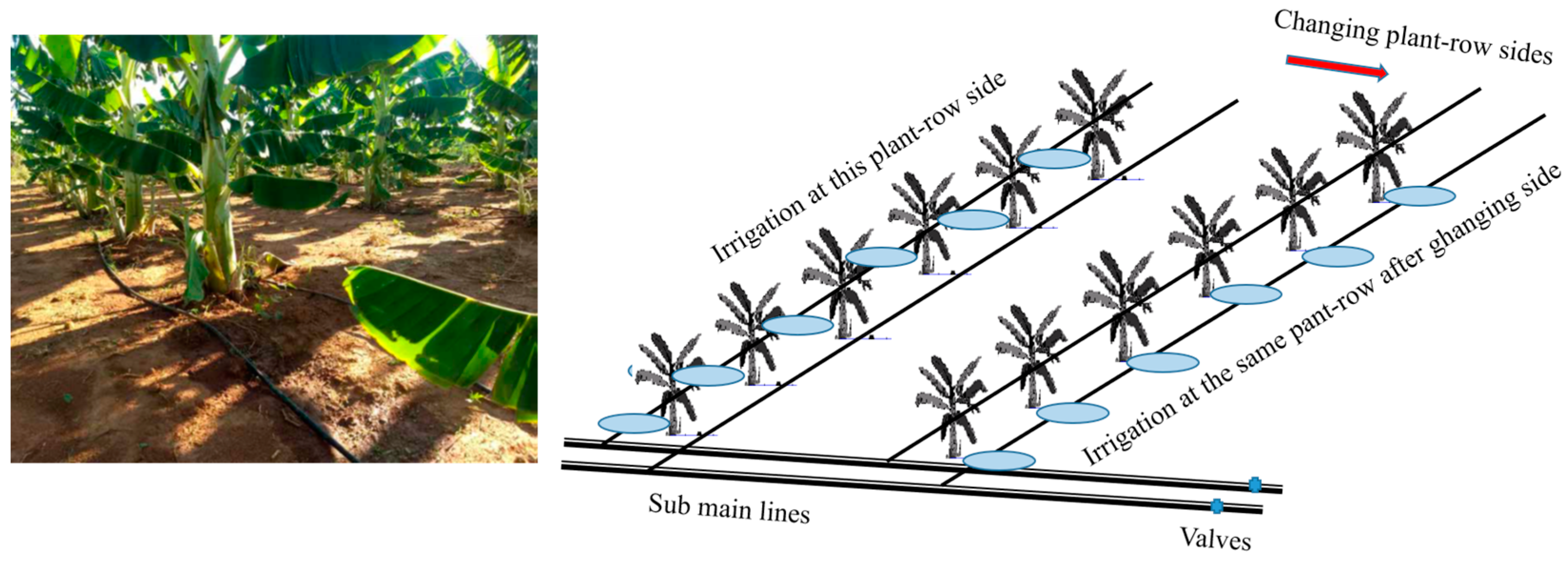
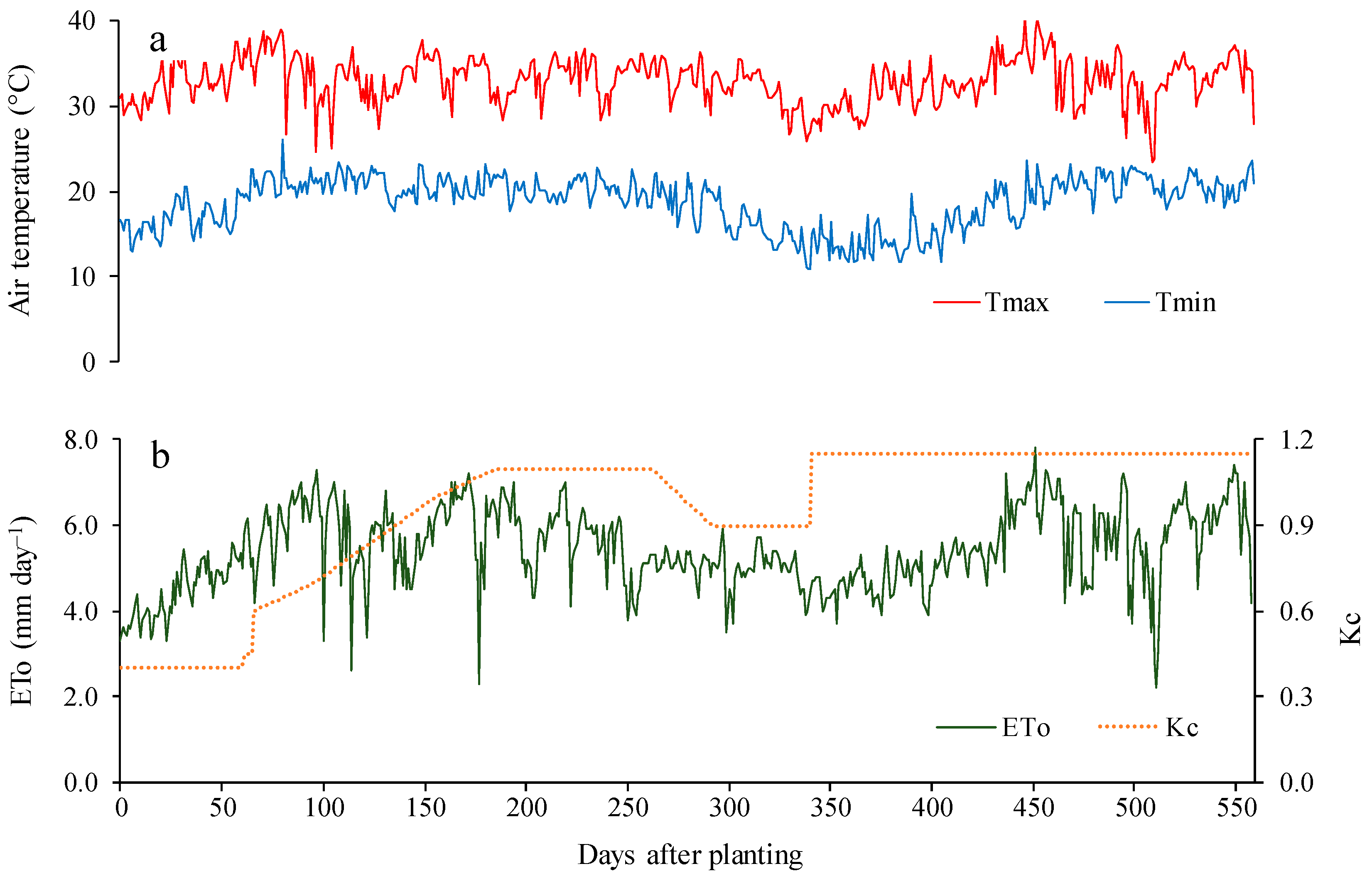


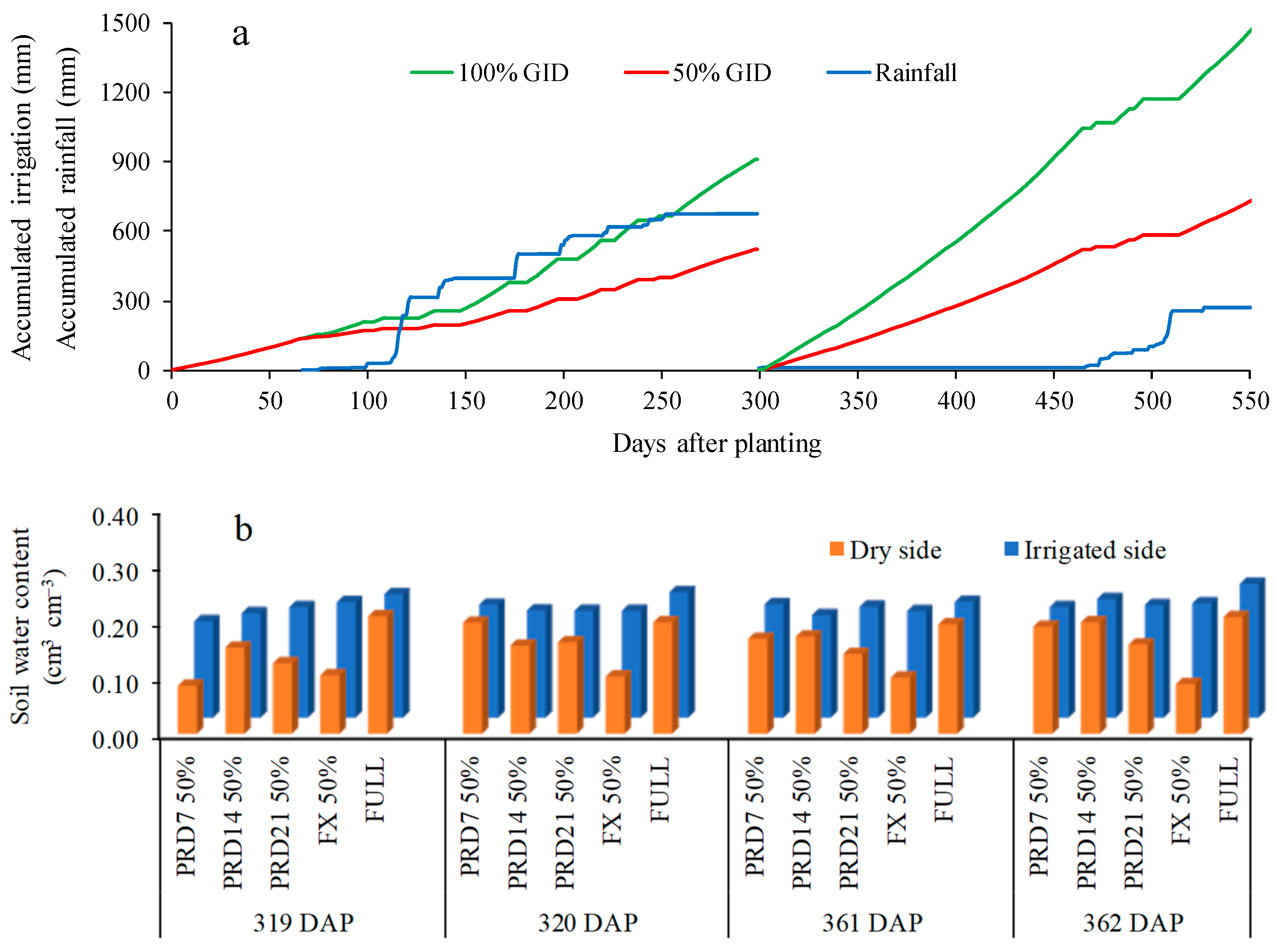
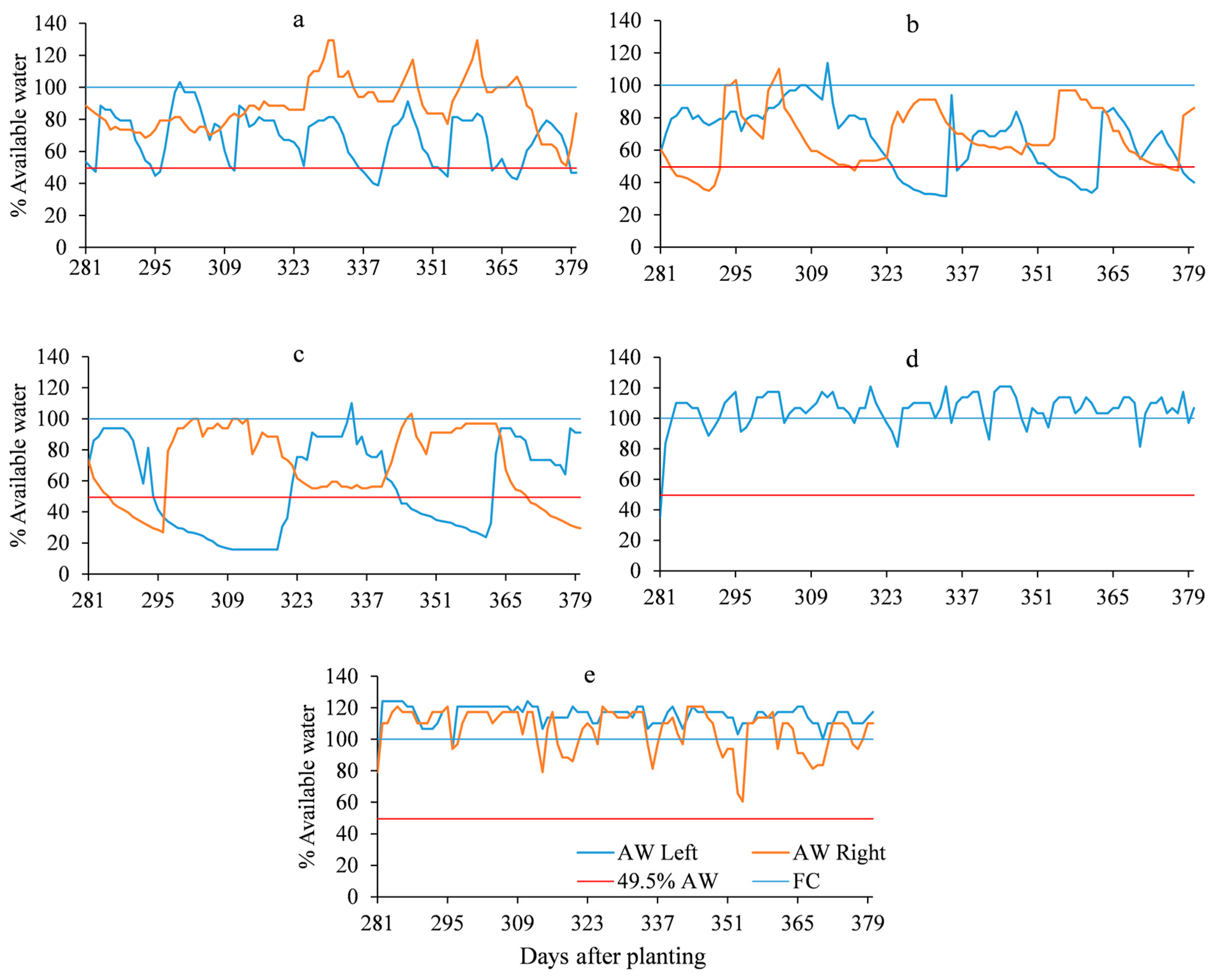
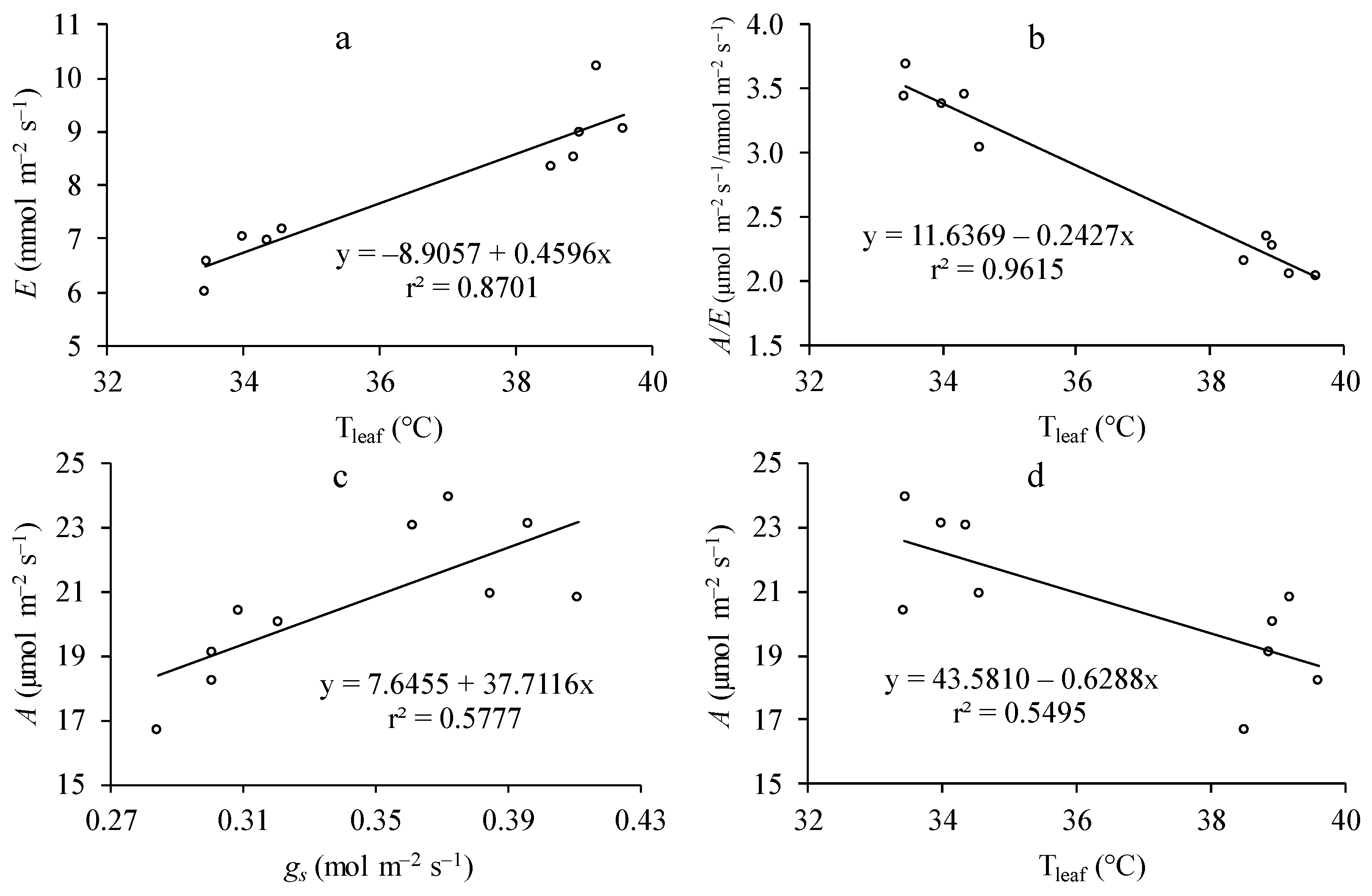
| Depth (m) | Sand | Silt | Clay | BD (kg dm−3) | Moisture (m3 m−3) at Tension (kPa) | ||||
|---|---|---|---|---|---|---|---|---|---|
| (g kg−1) | 10 | 33 | 100 | 500 | 1500 | ||||
| 0.00–0.20 | 673 | 51 | 276 | 1.44 | 0.1817 | 0.1533 | 0.1381 | 0.1316 | 0.1280 |
| 0.20–0.40 | 712 | 35 | 253 | 1.40 | 0.1864 | 0.1559 | 0.1376 | 0.1279 | 0.1268 |
| Irrigation Strategies | 319 DAP | 320 DAP | 361 DAP | 362 DAP | ||||
|---|---|---|---|---|---|---|---|---|
| Morning | Afternoon | Morning | Afternoon | Morning | Afternoon | Morning | Afternoon | |
| PRD7 50% | 0.353 | 0.277 | 0.474 | 0.275 | 0.474 | 0.414 | 0.275 | 0.563 |
| PRD14 50% | 0.460 | 0.377 | 0.456 | 0.442 | 0.456 | 0.430 | 0.442 | 0.559 |
| PRD21 50% | 0.409 | 0.331 | 0.430 | 0.319 | 0.430 | 0.473 | 0.307 | 0.572 |
| FX 50% | 0.434 | 0.475 | 0.441 | 0.282 | 0.441 | 0.507 | 0.295 | 0.369 |
| FULL | 0.385 | 0.447 | 0.457 | 0.329 | 0.457 | 0.526 | 0.329 | 0.676 |
| CV (%) | 43.35 | 32.81 | 20.63 | 32.41 | 20.63 | 36.98 | 33.16 | 36.69 |
| Physiological Variable | Period | PRD7 50% | ∆ (%) | PRD14 50% | ∆ (%) | PRD21 50% | ∆ (%) | FX 50% | ∆ (%) | FULL | CV (%) |
|---|---|---|---|---|---|---|---|---|---|---|---|
| Ci (µmol mol−1) | Morning | 211.0 | +1.9 | 220.40 | +6.5 | 228.40 | +10.3 | 209.40 | +1.2 | 207.00 | 5.80 |
| Afternoon | 205.8 | –8.4 | 206.40 | –8.1 | 209.40 | –6.8 | 227.80 | +1.4 | 224.60 | 7.36 | |
| E (mmol m−2 s−1) | Morning | 6.93 | +15.5 | 7.03 | +17.2 | 7.16 | +19.3 | 6.57 | +9.5 | 6.00 | 11.23 |
| Afternoon | 8.94 | +7.5 | 8.51 | +2.3 | 9.04 | +8.7 | 10.21 | +22.7 | 8.32 | 14.53 | |
| A (µmol m−2 s−1) | Morning | 23.03 | +13.1 | 23.12 | +13.5 | 20.94 | +2.8 | 23.94 | +17.5 | 20.37 | 11.66 |
| Afternoon | 20.01 | +19.8 | 19.11 | +14.4 | 18.22 | +9.1 | 20.83 | +24.7 | 16.70 | 12.21 | |
| gs (mol m−2 s−1) | Morning | 0.36 | +72.9 | 0.40 | +89.6 | 0.39 | +84.0 | 0.37 | +77.9 | 0.21 | 18.08 |
| Afternoon | 0.32 | +12.9 | 0.30 | +5.8 | 0.30 | +5.8 | 0.41 | +44.7 | 0.28 | 25.06 | |
| Tleaf (°C) | Morning | 34.36 | +2.7 | 34.02 | +1.7 | 34.57 | +3.4 | 33.48 | +0.1 | 33.45 | 1.92 |
| Afternoon | 38.94 | +1.1 | 38.88 | +0.9 | 39.60 | +2.8 | 39.19 | +1.7 | 38.53 | 3.02 |
| Irrigation Strategies | A/E (µmol m−2 s−1/mmol m−2 s−1) | A/Ci (µmol m−2 s−1/µmol mol−1) | A/Qleaf (µmol m−2 s−1/µmol m−2 s−1) | |||
|---|---|---|---|---|---|---|
| Morning | Afternoon | Morning | Afternoon | Morning | Afternoon | |
| PRD7 50% | 3.440 | 2.267 | 0.110 | 0.099 | 0.013 | 0.010 |
| PRD14 50% | 3.368 | 2.341 | 0.105 | 0.092 | 0.013 | 0.010 |
| PRD21 50% | 3.026 | 2.033 | 0.092 | 0.085 | 0.011 | 0.010 |
| FX 50% | 3.675 | 2.048 | 0.115 | 0.092 | 0.013 | 0.010 |
| FULL | 3.428 | 2.150 | 0.099 | 0.074 | 0.011 | 0.009 |
| CV (%) | 8.53 | 14.81 | 14.06 | 14.29 | 14.53 | 12.90 |
| Characteristics | Cycle | Irrigation Strategies | ||||||||||
|---|---|---|---|---|---|---|---|---|---|---|---|---|
| PRD7 50% | PRD14 50% | PRD21 50% | FX 50% | FULL | CV (%) | |||||||
| Plant height (m) | 1st | 2.12 | ab | 2.24 | a | 2.10 | b | 2.19 | ab | 2.19 | ab | 3.35 |
| 2nd | 2.92 | a | 3.22 | a | 3.00 | a | 2.92 | a | 3.20 | a | 5.37 | |
| Pseudostem (m) | 1st | 0.65 | ab | 0.67 | a | 0.66 | ab | 0.63 | b | 0.67 | a | 2.84 |
| 2nd | 0.73 | a | 0.80 | a | 0.76 | a | 0.74 | a | 0.81 | a | 6.05 | |
| Days to flowering (days) | 1st | 168.3 | a | 132.2 | bc | 148.1 | ab | 133.4 | ab | 127.4 | c | 16.06 |
| 2nd | 307.9 | a | 329.2 | a | 343.9 | a | 327.4 | a | 311.4 | a | 10.22 | |
| N° living leaves at flowering (un) | 1st | 18.5 | a | 18.4 | a | 18.5 | a | 18.5 | a | 18.6 | a | 5.04 |
| 2nd | 14.8 | a | 13.8 | a | 14.1 | a | 14.4 | a | 14.7 | a | 4.92 | |
| Characteristics | Cycle | Irrigation Strategies | ||||||||||
|---|---|---|---|---|---|---|---|---|---|---|---|---|
| PRD7 50% | PRD14 50% | PRD21 50% | FX 50% | FULL | CV (%) | |||||||
| Number of fruits per bunch (un) | 1st | 101 | b | 106 | ab | 108 | ab | 105 | ab | 116 | a | 6.20 |
| 2nd | 106 | a | 120 | a | 113 | a | 108 | a | 126 | a | 9.63 | |
| Length of central fruit of the 2nd hand (cm) | 1st | 14.3 | a | 14.3 | a | 14.8 | a | 14.0 | a | 14.5 | a | 5.36 |
| 2nd | 16.3 | b | 17.0 | ab | 17.4 | ab | 17.6 | ab | 18.3 | a | 4.77 | |
| Diameter of central fruit of the 2nd hand (mm) | 1st | 31 | a | 33 | a | 33 | a | 32 | a | 33 | a | 3.46 |
| 2nd | 36 | a | 36 | a | 35 | a | 35 | a | 37 | a | 2.69 | |
| Mass of central fruit of the 2nd hand (g) | 1st | 92.8 | a | 108.1 | a | 110.3 | a | 109.9 | a | 112.8 | a | 16.09 |
| 2nd | 126.7 | b | 138.2 | b | 140.4 | ab | 143.9 | ab | 157.5 | a | 7.04 | |
| N° living leaves at harvest (un) | 1st | 6.5 | a | 7.4 | a | 6.6 | a | 7.4 | a | 7.4 | a | 25.54 |
| 2nd | 10.4 | a | 10.0 | a | 10.3 | a | 10.0 | a | 11.1 | a | 7.20 | |
| Total leaf area (m2) | 1st | 3.61 | a | 4.44 | a | 4.13 | a | 4.62 | a | 4.52 | a | 28.21 |
| 2nd | 7.10 | a | 7.68 | a | 7.87 | a | 7.58 | a | 9.30 | a | 16.34 | |
| Water productivity—WP (kg ha−1 mm−1) | 1st | 40.51 | ab | 45.18 | a | 48.07 | a | 46.16 | a | 29.83 | b | 14.04 |
| 2nd | 47.46 | a | 52.70 | a | 51.13 | a | 50.56 | a | 30.49 | b | 10.29 | |
| Yield of hands (Mg ha−1) | 1st | 7.10 | a | 7.68 | a | 7.87 | a | 7.58 | a | 9.30 | a | 16.34 |
| 2nd | 29.85 | b | 33.14 | ab | 32.16 | ab | 31.80 | ab | 38.35 | a | 11.35 | |
Disclaimer/Publisher’s Note: The statements, opinions and data contained in all publications are solely those of the individual author(s) and contributor(s) and not of MDPI and/or the editor(s). MDPI and/or the editor(s) disclaim responsibility for any injury to people or property resulting from any ideas, methods, instructions or products referred to in the content. |
© 2024 by the authors. Licensee MDPI, Basel, Switzerland. This article is an open access article distributed under the terms and conditions of the Creative Commons Attribution (CC BY) license (https://creativecommons.org/licenses/by/4.0/).
Share and Cite
Almeida, F.P.d.; Santos, M.R.d.; Coelho, E.F.; Donato, S.L.R.; Oliveira, P.M.d.; Reis, J.B.R.d.S.; Carvalho, L.A.C.d.; Lima, J.C.L.d.; Santos, D.L.; Cunha, F.F.d. Irrigation of ‘Prata-Anã’ Banana with Partial Root-Zone Drying in a Semi-Arid Environment. Agronomy 2024, 14, 1820. https://doi.org/10.3390/agronomy14081820
Almeida FPd, Santos MRd, Coelho EF, Donato SLR, Oliveira PMd, Reis JBRdS, Carvalho LACd, Lima JCLd, Santos DL, Cunha FFd. Irrigation of ‘Prata-Anã’ Banana with Partial Root-Zone Drying in a Semi-Arid Environment. Agronomy. 2024; 14(8):1820. https://doi.org/10.3390/agronomy14081820
Chicago/Turabian StyleAlmeida, Felipe Pires de, Marcelo Rocha dos Santos, Eugênio Ferreira Coelho, Sérgio Luiz Rodrigues Donato, Polyanna Mara de Oliveira, João Batista Ribeiro da Silva Reis, Luiz Antonio Conceição de Carvalho, José Carlos Lopes de Lima, Dionei Lima Santos, and Fernando França da Cunha. 2024. "Irrigation of ‘Prata-Anã’ Banana with Partial Root-Zone Drying in a Semi-Arid Environment" Agronomy 14, no. 8: 1820. https://doi.org/10.3390/agronomy14081820
APA StyleAlmeida, F. P. d., Santos, M. R. d., Coelho, E. F., Donato, S. L. R., Oliveira, P. M. d., Reis, J. B. R. d. S., Carvalho, L. A. C. d., Lima, J. C. L. d., Santos, D. L., & Cunha, F. F. d. (2024). Irrigation of ‘Prata-Anã’ Banana with Partial Root-Zone Drying in a Semi-Arid Environment. Agronomy, 14(8), 1820. https://doi.org/10.3390/agronomy14081820








